It's hard to talk about what Valve's The Orange Box offers without immediately falling into an impression of some sort of late-night pitchman for fantasy knives and alternative cleaning products. That's partially because the name "The Orange Box" sounds more like some kind of citrus-scented bathroom cleanser than a video game, and partially because this five-games-in-one package is the kind of crazy deal that almost forces you to shout "Now how much would you pay?" With three amazing new games and two classics all in one package, it's impossible to go wrong with The Orange Box.
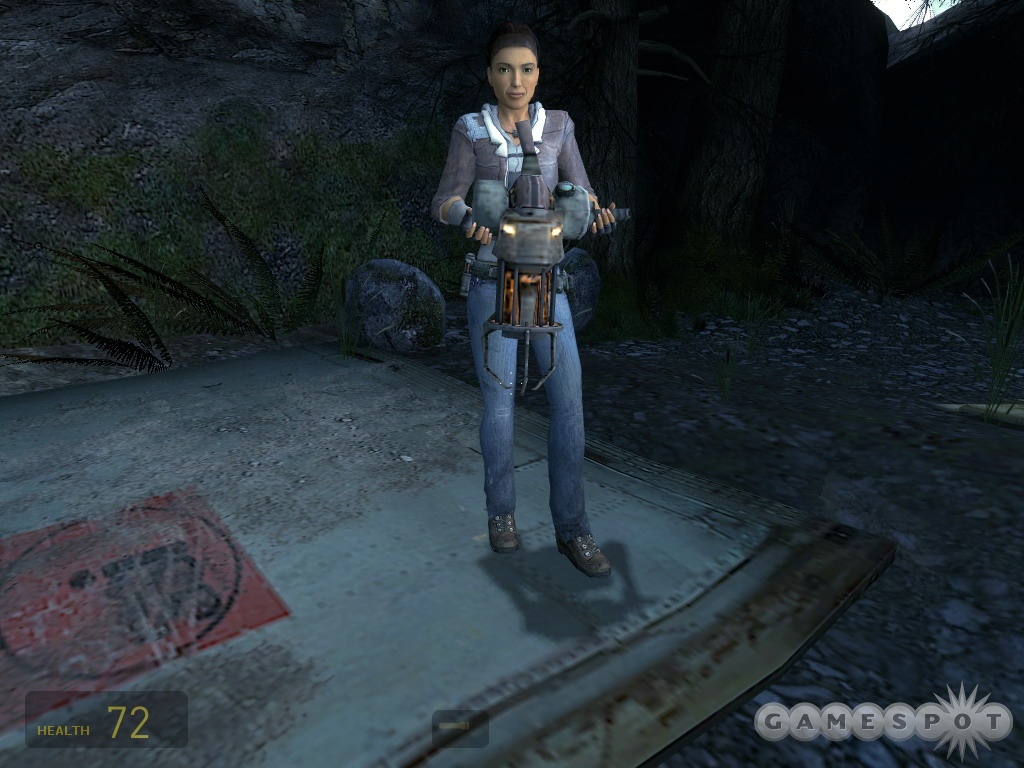
With your purchase of The Orange Box, you'll get Half-Life 2: Episode Two, Team Fortress 2, and Portal. They're all based on the same graphics engine, but they're all incredibly different games, which ensures that there's something for everyone. You'll also get 2004's Half-Life 2 and 2006's Half-Life 2: Episode One, which is handy if you aren't up to speed with what Gordon Freeman's been doing over the past few years. On the PC, you'll launch each game separately. On the Xbox 360, the game boots up to a menu where you can easily select any of the five games, and quitting out of a game brings you back to the selection menu.
Let's start with new stuff. Episode Two is the continuation of the Half-Life 2 story. It picks up right where Episode One leaves off, with Alyx helping Gordon out of the rubble of a train crash. You've escaped from City 17, which now looks more like a smoking crater in the ground with a huge, swirling portal floating over it. But you aren't safe just yet. You've escaped with information that the Combine very much wants to get back from you, so the chase is on again. Fortunately, you'll do much more than just run in Episode Two. The biggest difference here is that Alyx doesn't directly accompany you through the entire game. You'll split up much more frequently, so, for example, you'll find yourself working your way through antlion nests and crushing antlion grubs all by your lonesome. You'll also negotiate a mine with the help of a vortigaunt who happens to serve as a subtle form of comic relief. It spouts dialogue that plays off of the serious, spiritual tone that most of these aliens take, only applying it to things such as crates full of supplies that just flew down a broken mineshaft and out of reach. These bits alone give Episode Two a much different tone than the previous games, but there are also significant gameplay alterations.
Episode Two marks the return of the lengthy vehicle sequences seen in Half-Life 2. There's a large block of action that takes place with you moving from spot to spot in what appears to be a stripped-down Dodge Charger. There are also a couple of big set pieces, such as one sequence where you have to defend the center of a mine from relentless antlion attacks. Likewise, the game's final sequence takes place in a wide-open area and, without getting too specific, feels very different from anything Half-Life 2 has done so far. Although you won't encounter any new weapons in Episode Two, the developers have at least broken the flashlight power meter out from the same auxiliary power that you use to sprint. This is a smart change that doesn't make much sense in terms of continuity between episodes, but it's handy and the sort of thing you wish they'd roll back into the much darker, much more flashlight-oriented action of Episode One. At about four or five hours, Episode Two is also longer than Episode One.
With all that Half-Life, you'd think that the other two parts of this package would be minor additions thrown in to make the deal sound more attractive. But Portal is probably the greatest thing about The Orange Box. It's a clever mix that combines first-person action with very focused puzzle-solving. It's also completely hilarious. The premise is simple. You're a woman who wakes up in a tiny box inside some lab facility run by a mysterious company called Aperture Science. You're presented with a portal that lets you walk out of the room and into another. From there, the game gradually introduces you to portals and eventually gives you a gun that you can use to fire portals onto walls, ceilings, and floors. Your primary and alternate fire buttons are used to create blue and orange portals, respectively, and walking, jumping, or falling into one portal sends you out of the other one. You can also pick up objects, such as large boxes, which often must be placed on large buttons to open doors so you can proceed through a variety of test chambers.
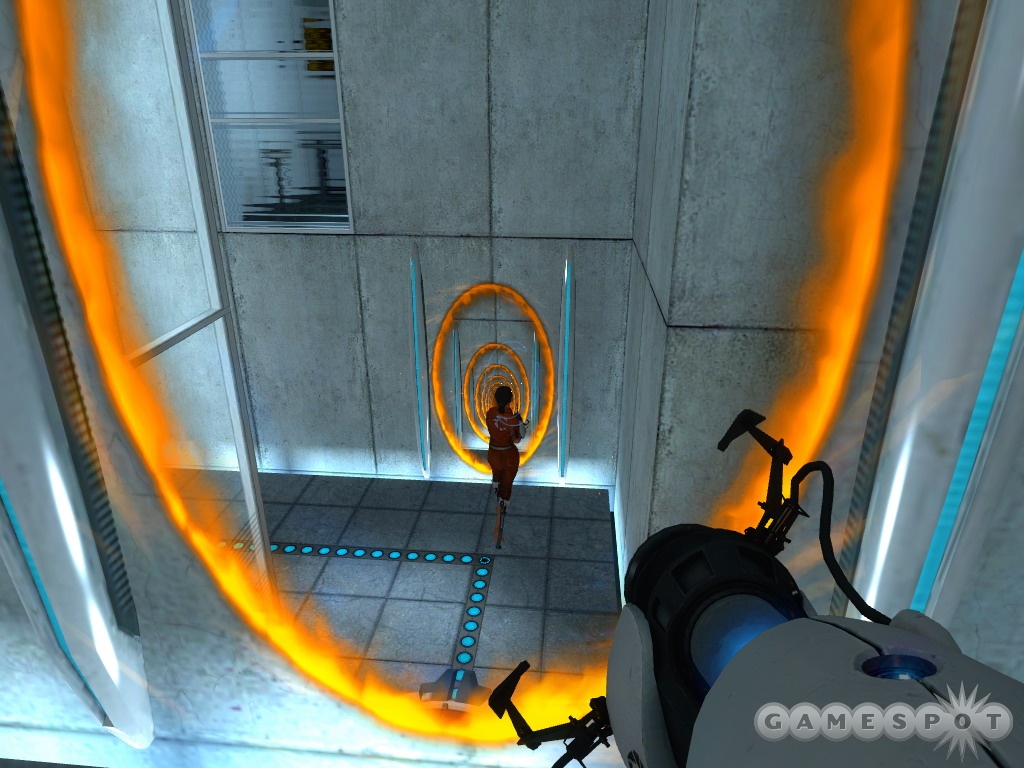
Along the way, a computerized female voice guides you...and misguides you. The dialogue from the computer supervising your test gets more and more overtly funny as you play and leads to a very satisfying conclusion, including what might be the best end-credit song ever written. Later puzzles force you to pull off some tricky portal maneuvers and require you to consider how much momentum you have when you enter a portal, given that the same momentum is carried with you when you come out the other side. So if you jump down into a floor portal and have the exit portal set on a side wall, you'll rocket out of that portal with the velocity you had when falling into the hole on the floor.
Upon finishing Portal, which may take you three hours or so if you're able to quickly grasp the concepts that are presented, you'll unlock a series of advanced challenges. These include six harder versions of puzzles from the main game, and challenges that ask you to finish levels under certain limits, such as the time it takes you to complete the level, the number of portals you use, or the number of steps you take. The advanced puzzles are tough, but not impossible. However, the challenges are much rougher. There are bronze, silver, and gold medals awarded for each of the three challenge types across six levels. Even after you've figured out the puzzles, Portal remains fun and is worth coming back to again and again, just to listen to the dialogue and spend a few fleeting moments with the weighted companion cube. It's a shame that it had to end this way.
Team Fortress 2 is the multiplayer component to The Orange Box, and it's been a long time coming. Almost a decade, in fact. But we'll leave out the history lesson and get right down to business. Like its predecessor, Team Fortress 2 is a class-based multiplayer shooter in which the red team dukes it out with the blue team. There are six maps in the game, each with its own set of objectives. So 2fort is your basic "capture the flag" type of game, wherein each team tries to get into the basement, collect the enemy's intelligence (a briefcase), and return it home. The rest of the maps deal with the capture and defense of control points in different ways. For example, some maps put both teams on a course to capture the enemy's base, but require you to control the other points on the map to get a shot at the final objective. Hydro is an interesting map because it takes the control-point concept a little further by breaking each point up into its own specific area of the map. After each capture, the game is reset; a different part of the level is used for the next conflict, which makes it feel like multiple maps in one level. That's a good thing, too, because the downside of TF2 is that there are only six maps to choose from, and 2fort is the only capture-the-flag map.
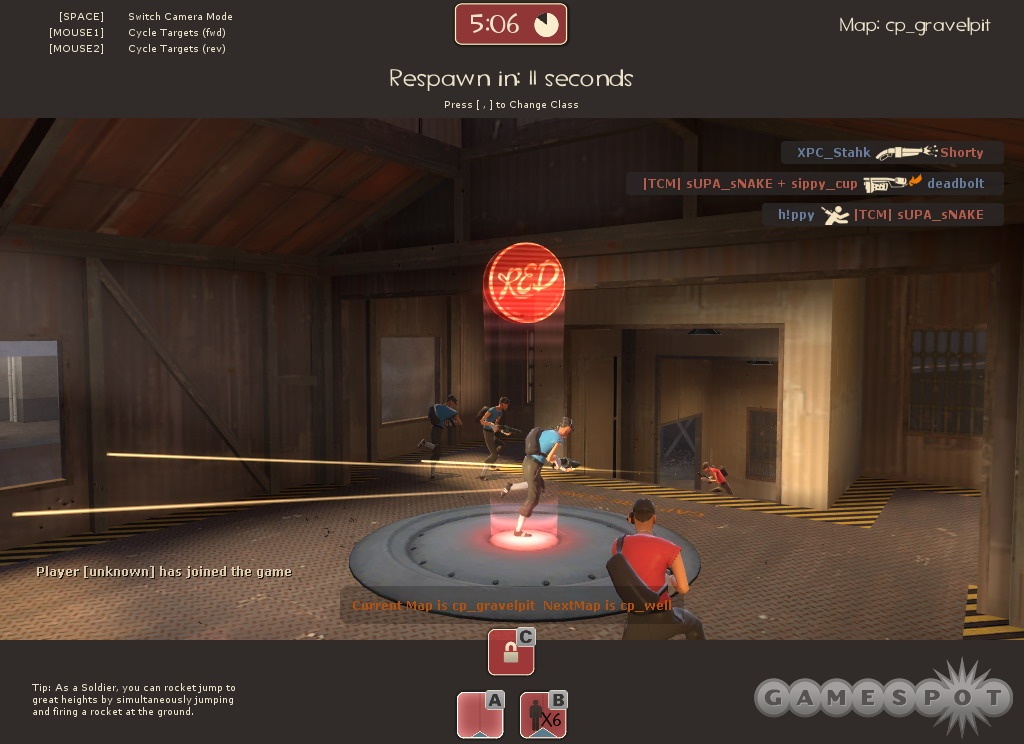
Choosing your character class is a vitally important decision. The right answer is a mixture of personal preference and your current situation, because each class has unique weapon loadouts and abilities. The scout can't take as much damage as other classes, but he's faster, can double jump, and captures control points twice as quickly as other classes, which makes him a vital but fragile man on the battlefield. The soldier is your standard no-frills class, but his default weapon is a rocket launcher, which is handy. The pyro packs a flamethrower, which is fun to use. Then there's the demo man as well as the heavy, both of whom are slower-moving, tougher targets that bring heavy firepower along with them. The engineer's main weapon is a shotgun, but he can also build things such as turrets and teleporters, which can have a huge impact on the game. The medic can heal other players and let out an ubercharge that can turn players invincible for brief periods of time. Teaming up a medic with a heavy can be an incredibly devastating combo. There's a sniper class for those who like to shoot people in the face from long distances. Finally, there's the spy class, which you can use to disguise yourself as a member of the opposite team, turn invisible, and place sappers that eliminate pesky engineer turrets. The classes feel as if they've been balanced out fairly well, and for each action there's an appropriate counter. But none of that sounds particularly special, does it?
The thing that makes Team Fortress 2 so special is its graphical style. Rather than going with the ultrarealistic military look that's still all the rage these days with the kids, TF2 has an over-the-top, cartoonish design to it that starts with the great-looking characters. They're really well animated, and each class just has a ton of personality. The level design holds up its end of the bargain, with a visual style that occasionally reminds you of old Road Runner cartoons with their rocky, Southwestern styles.
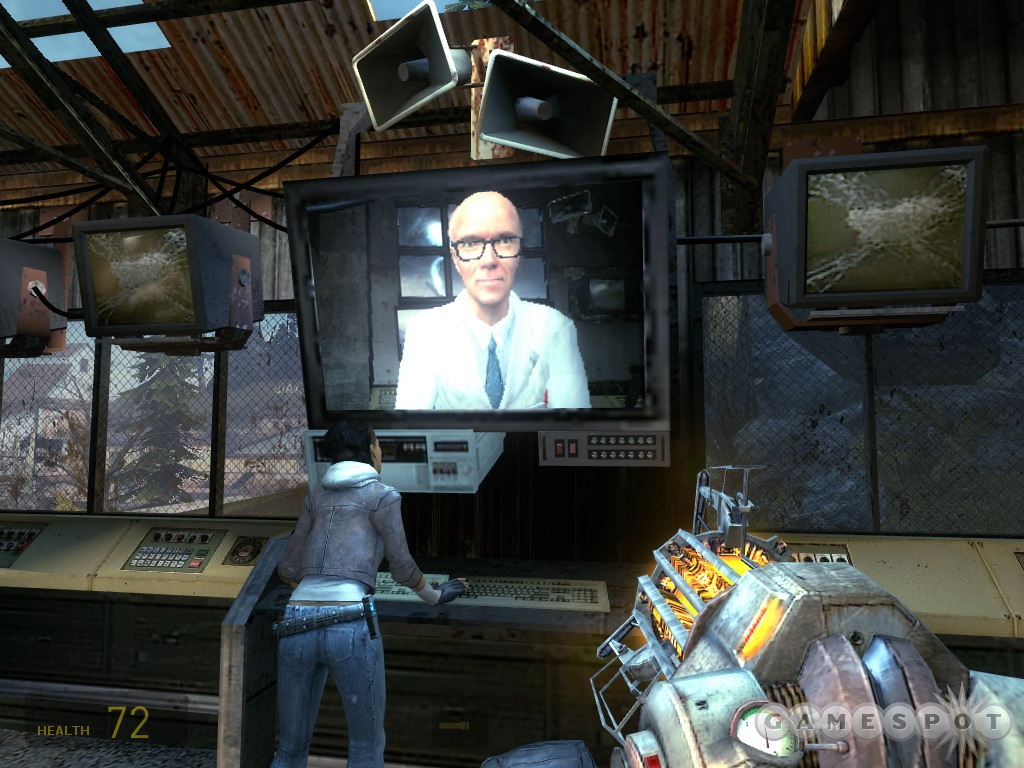
In case you haven't played the two already-released games in the Half-Life 2 saga, they tell the story of Gordon Freeman, your silent protagonist. At the end of the original Half-Life, the scientist was placed into stasis by a mysterious, nameless figure known outside of the HL universe as the G-Man. This governmental-looking guy pops up right at the beginning of HL2 to awaken Gordon and, apparently, place him on a train headed into City 17. This is a very different world than the one Gordon left behind. Time has passed, though it's unclear how much. The alien invasion from the first Half-Life has resulted in the Seven Hour War, at the end of which humanity surrendered to a force now known as the Combine. But even with the human race under complete lockdown, there's still a group of rebels out there fighting for freedom. Some of these rebels are scientists that come directly from the Black Mesa facility where the original Half-Life took place. You quickly hook up with the rebels and the "good" aliens, the vortigaunts, all of whom speak of you in hushed tones, as though you were a legendary hero. Half-Life 2 is a very lengthy adventure with somewhat odd pacing. The game contains two very long vehicle sequences that perhaps go on a bit too long, but let's let sleeping dogs lie. This 2004 game is an absolute classic that should be played and enjoyed by almost anyone that comes into contact with it.
Episode One picks up right after the events of Half-Life 2 and serves as a sort of epilogue to the Half-Life 2 story. Without going too deep into the plot events, City 17 is about to blow up and you are way too close to it to survive the blast. Joining you is Alyx Vance, a girl that pops up to fight alongside you at various points in Half-Life 2. Here, she's with you for most of the game, for better and for worse. On the one hand, she's a great computer-controlled gunner who feels almost indestructible, which means that you can sit back and let her do most of the fighting if you feel like it. On the other hand, her excitable nature can be a little grating, and it feels as if she's along for the ride just to point out stuff that the developers wanted you to see. Most of her speech seems to follow the formula of "Hey, Gordon, look at this [key item you need to interact with to proceed]" or "Whoa, look at this [scripted sequence of things falling down or exploding]!"
The story is probably the weakest point about Episode One, considering that nothing really happens. You start playing, and your goal is to delay the blast; you do that, and then escape. Along the way, though, you'll experience some neat gameplay, much of which is built around the use of the gravity gun. Compared to the huge adventure in Half-Life 2, Episode One was a weird way to continue the adventure. Now that you can play it as a three- or four-hour chunk of a larger package, it works much better.
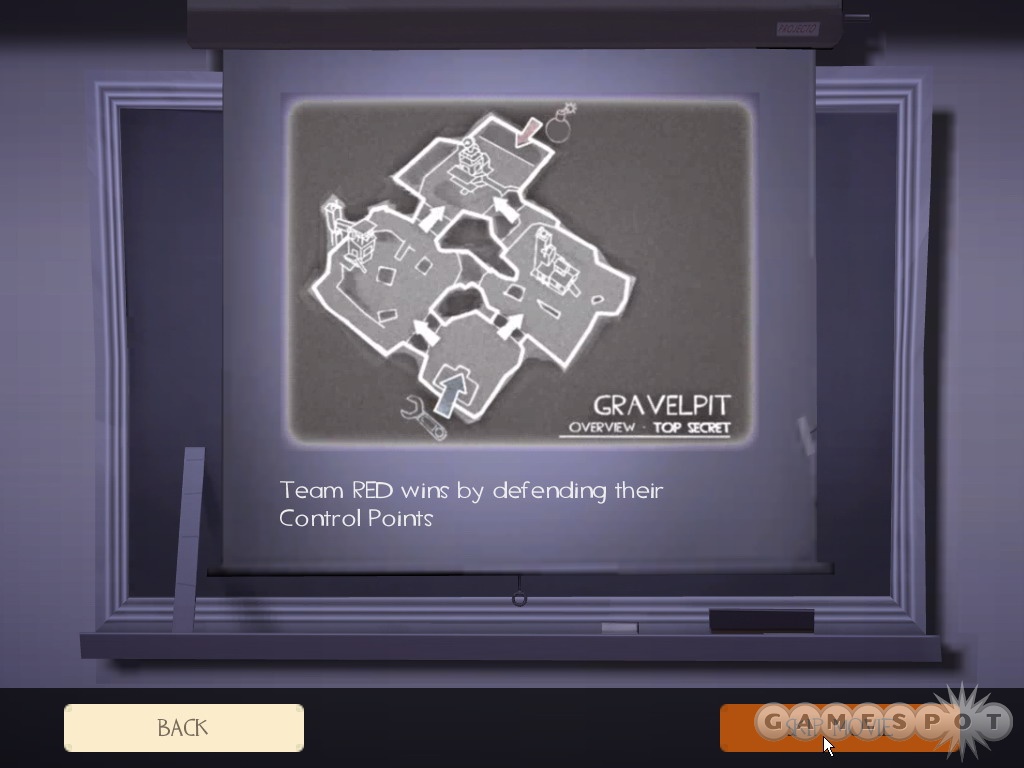
By comparison, the graphics in the Half-Life games and in Portal are vastly different, even though all of these games are running on variations of the same engine. The Half-Life 2 games do a great job of showing you torn-apart human cities and postapocalyptic landscapes, and they still have some of the best facial animation you'll see in a video game. Portal has a pristine laboratory look to most of its levels that really fits with the game's premise, and the effects for the portals themselves are pretty cool. TF2's unique visual style sets it apart from the cookie-cutter military shooters out there and injects some humor into the proceedings at the same time.
The package also has wonderful sound across all of its games. Half-Life 2 and its additional episodes probably have the best (and most) music of the bunch, and the soundtrack in the Half-Life games is really great. Portal and TF2 definitely have some good music, as well. Likewise, there's a healthy amount of voice acting across the five games, and most of it is quite good. The Team Fortress 2 classes all have specific voice taunts that add to their personalities. Portal's computer voices are outstanding, and the different characters in Half-Life 2 turn in terrific and believable performances.
With The Orange Box out on both the PC and the Xbox 360, it's worth noting that there are a handful of differences between them, but it's hard to go wrong with either version. For starters, the PC version is $10 cheaper and, provided that you have modern hardware, it also looks better than the Xbox 360 version. The 360 version doesn't run as smoothly, though its frame rate is hardly a problem, either. Furthermore, the textures used throughout Half-Life 2 simply don't look as good in 2007 as they did in 2004. Consequently, viewing them on a large HDTV doesn't really do them any favors, though the 360 version utilizes high dynamic range lighting that gives you more realistic-looking effects than Half-Life 2 had on the PC at its time of release.
Of course, the 360 version has achievement points. In fact, it has 99 separate achievements, more than any other game to date, though they still total up to 1,000 points overall. Spreading the 1,000 across five games means that no single achievement is worth very much, even though some of them ask you to do some out-of-the-ordinary things, such as playing through the entire Ravenholm chapter using only the gravity gun, or finishing Episode One and firing exactly one bullet over the course of the entire game. Each game has an achievement browser that shows you the achievements that relate to that specific game, though some of the achievements for the Half-Life 2 games cross over from one game to another.
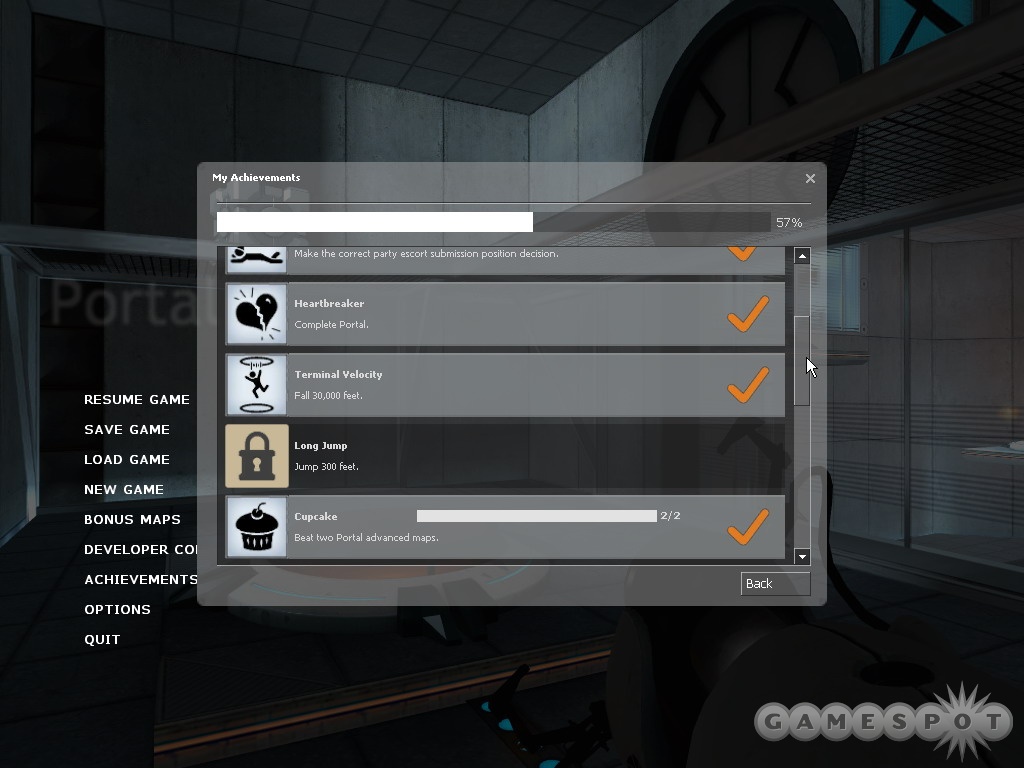
The achievement browser that Valve has built also shows your progress in some cases. For example, there's an achievement for smashing every single antlion grub in Episode Two. The catch is that there are 333 grubs in all. It's nice to know how many you have left. On the PC, Valve has rolled an achievement system into Steam, its digital content delivery system. The community side of Steam now lets you look at how long players spend playing each game, and the same achievements used in Team Fortress 2, Portal, and Episode Two are also present in your Steam profile. The difference is that they don't tie back into your Microsoft-branded gamertag, and there's no point count associated with each achievement on the PC, either. It's an interesting addition to the service, which is becoming quite a service these days, though we're still patiently waiting for a fully digital burrito-delivery system to be implemented.
But that's beside the point. You don't need burritos, sealed dealer cases of baseball cards, or fully integrated fitness systems thrown in at no additional charge to make The Orange Box a great deal. It's practically guaranteed that if you enjoy video games, you'll find at least one thing to like in this collection, though there's also a very good chance that you'll really enjoy all of it.



